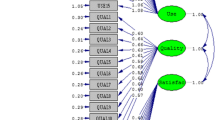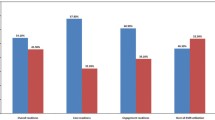Abstract
Electronic medical records are generally used by nurses in hospitals. However, studies investigating views on and evaluations of electronic medical records by nurses are limited in Turkey and in other countries around the world. Thus, in this study, nurses’ views on electronic medical record systems will be investigated in terms of use, quality and user satisfaction. Our goal was to investigate the views on electronic medical records used by nurses working at hospital clinics (inpatient care units). Moreover, in this study, we will examine whether there are relationships among the use, quality and user satisfaction of electronic medical records. This study is composed of field research conducted using questionnaires. To prepare the data-measuring instrument, the literature on electronic medical records was reviewed. In addition, during the pilot run of the questionnaire, some revisions were made to the measuring instrument to account for the views of nurse managers in the field. The questionnaire consists of 35 items: 12 items for use, 12 items for quality and 11 items for user satisfaction. A Likert scale type was used in this questionnaire. Responses for usage and quality were assigned a value of 1–5 (‘never/almost never/not at all’ to ‘always/almost always’) for each item. Responses for user satisfaction were assigned a value of 1–5 (‘not at all’, to ‘very great’) for each item. The study was planned and conducted on nurses working at inpatient care units at one public university hospital, one Turkish Ministry of Health hospital and one private hospital in Kocaeli. A sampling technique was not used because we aimed to conduct the questionnaire among all nurses. At the end of this study, the questionnaire had been conducted on 200 nurses. We found that the average score for the nurses’ satisfaction with electronic medical records was 3.28, the average score for using electronic medical records was 1.96, and the average score for the quality of electronic medical records was 3.16. We also determined that there are significant relationships among the use, quality and user satisfaction of electronic medical records. This study revealed that there are significant differences among the mean quality scores for the EMR systems in the Ministry of health hospital, the university hospital and the private hospital. Interestingly, 59.0% of all participants in this study felt that EMR systems were not well integrated into their workflow. In addition, half of all respondents had not been trained in using EMR systems.
Similar content being viewed by others
References
Howard R. Nurse acceptance and perception of electronic medical record. Kentucky: Department of Advanced Nursing Studies, Northern Kentucky University; 2009. Master of Science Thesis.
Barnette, M. T. Lived Experiences of registered nurses: Impact of the electronic medical record. School of Human Services, Capella University; 2009. Doctor of Philosophy Thesis.
Farsi, A. L., and West, D. J. Use of electronic medical records in Oman and physician satisfaction. J. Med. Syst. 30(1):17–22, 2006.
Chaudhry, B., Wang, J., Maglione, M., Mojica, W., Roth, E., Morton, S. C., et al. Systematic review: Impact of health information technology on quality, efficiency, and cost of medical care. Ann. Intern. Med. 144:742–752, 2006.
Fung, C. H., Woods, J. N., Asch, S. M., Glassman, P., and Doebeling, B. N. Variation in implementation and use of computerized clinical reminders in an integrated healthcare system. Am. J. Manage. Care. 10(2):878–885, 2004.
Likourezos, A., Chalfin, D. B., Murphy, D. G., Sommer, B., Darcy, K., and Davidson, S. J. Physician and nurse satisfaction with an electronic medical record system. J. Emerg. Med. 27(4):419–424, 2004.
Dick, R. E., and Steen, E. The computer based patient record: an essential technology for health care. Washington D.C.: National Academy Press, 1991.
Goorman, E., and Berg, M. Modelling nursing activities: electronic patient records and their discontents. Nurs. Inq. 7:3–9, 2000.
Mekhijian, H. S., Kumar, R. R., Kuehn, L., Bentley, T. D., Teater, P., Thomas, A., Payne, B., and Ahmad, A. Immediate benefits realized following implementation of physician order entry at an academic centre. J. Am. Med. Inform. Assoc. 9(5):529–539, 2002.
Pizzi, L. T., Suh, D. C., Barone, J., and Nash, D. B. Factors related to physicians’ adoption of electronic prescribing: results from a national survey. Am. J. Med. Qual. 20:22–32, 2005.
Otieno, O. G., Toyama, H., Asonuma, M., Kanai-Pak, M., and Naitoh, K. Nurses’ views on the use, quality and user satisfaction with electronic medical records: questionnaire development. J. Adv. Nurs. 60(2):209–219, 2007.
Bates, D. W. The quality case for information technology in healthcare. BMC Med. Inform. Decis. 2:7–25, 2002.
Getty, M., Ryan, A. A., and Ekins, M. L. A comparative study of the attitudes of users and non-users towards computerized care planning. J. Clin. Nurs. 8(4):431–439, 1999.
Gremy, F., Fessler, J. M., and Bonnin, M. Information systems evaluation and subjectivity. International Journal of Medical Informatics. 56:13–23, 1999.
Lee, F. W. Adoption of electronic medical records as a technology innovation for ambulatory care at the medical university of South Carolina. Health Inf. Manage. 21(1):1–20, 2000.
Lee, T. T., Lee, T. Y., Lin, K. C., and Chang, P. C. Factors affecting the use of nursing information systems in Taiwan. J. Adv. Nurs. 50(2):170–178, 2005.
Lærum, H., Ellingsen, G., and Faxvaag, A. Doctors’ use of Electronic Medical Records Systems in Hospitals: Cross Sectional Survey. Br. Med. J. (BMJ). 323:1344–1348, 2001.
Burkle, T., Ammenwerth, E., Prokosch, H. U., and Dudeck, J. Evaluation of clinical information systems. What can be evaluated and what cannot? J. Eval. Clin. Pract. 7:373–385, 2001.
Goossen, W. T. F. Nursing information management and processing: A framework and definition for system analysis, design and evaluation. Int. J. Biomed. Comput. 40:187–195, 1996.
Ngin, P., Simms, L. M., and Erbin-Roesemann, M. Work excitement among computer users in nursing. Comput. Nurs. 11:127–133, 1993.
Axford, R. I., and Carter, B. E. L. Impact of clinical information systems on nursing practice/nurses’ perspectives. Comput. Nurs. 14:156–63, 1996.
Van Bemmel, J. H., and Musen, M. A. A Handbook of Medical Informatics. Heidelberg: Springer-Verlag, 1997.
Lee, T. T., Yeh, C. H., and Ho, L. H. Application of a computerized nursing care plan system in one hospital: Experience of ICU nurses in Taiwan. J. Adv. Nurs. 39(1):61–67, 2002.
Roemer, L. K., Richardson, S. J., Sward, K., and Tilley, C. Redundancy in a computer-generated order list: meeting the needs of nurses at various levels of practice expertise. Comput. Inform. Nurs. 23(2):73–82, 2005.
Lee, T. T. Evaluation of computerized nursing care plans: instrument development. J. Prof. Nurs. 20(4):230–238, 2004.
Aronsky D, Haug PJ. Assessing the quality of clinical data in a computer-based record for calculating the pneumonia severity index. J. Am. Med. Inform. Assoc. 7(1):55–65, 2000.
Laerum, H., and Faxvaag, A. Task-oriented evaluation of electronic medical records systems: development and validation of a questionnaire for physicians. BMC Medical Informatics and Decision Making. 4(1), 2004. Available at http://www.biomedcentralcom/content/pdf/1472-6947-4-1.pdf. Accessed 10 April 2010.
Joos, D., Chen, Q., Jirjis, J., and Johnson, K. B. An Electronic Medical Record in Primary Care: Impact on Satisfaction, Work, Efficiency and Clinic Processes. AMIA Annu. Symp. Proc. 394–398, 2006.
Kossman, S., and Scheidenhelm, S. Nurses’ perceptions of the impact of electronic health records on work and patient outcomes. Comput. Inform. Nurs. 26(2):69–77, 2008.
DeLone, W. H., and McLean, E. R. Information systems success revisited. In Proceeding of 35th Hawaii International Conference on System Science. Washington DC, USA: IEEE Computer Society. 238, 2002.
Kirshbaum, M. N. Are we ready for the electronic patient record? Attitude and perceptions of staff from two NHS trust hospitals. Health Inform. J. 10(4):265–276, 2004.
Otieno, G. O., and Hosoi, R. Factors influencing diffusion of electronic medical records: a case study in three healthcare institutions in Japan. Health Inf. Manag. J. 34(4):120–129, 2005.
Bingham, A. Computerized patient records benefits physician offices. Healthc Financ. Manage. 51(9):68–70, 1997.
Hatcher, M., and Heetebry, I. Information Technology in the future of healthcare. J. Med. Syst. 28(6):673–688, 2004.
Miller, R., and Sim, I. Physician’s use of electronic medical records: barriers and solutions. Health Aff. 23(2):116–126, 2004.
Darr, A., Harrison, M., Shakked, L., and Shalom, N. Physicians’ and nurses’ reactions to electronic medical records systems. J. Health Organ. Manag. 17(5):349–359, 2003.
Sitting, D., Kuperman, G., and Fiskio, J. Evaluating physician satisfaction regarding user interactions with ElectronicMedical Records System. Proc AMIA Symp. 1999: 400–404. Available at www.Amia.org/pubs/symposia. Accessed 10 December, 2009.
Ayyad, Q. Nursing satisfaction with the computerized nursing records. Paper presented at the Meeting of Nursing Day, Oman, 2002.
Cook, T. D., and Campbell, D. T. Quasi-experimentation design and analysis issues for field settings. Boston: MA: Houghton Mifflin Company, 1979.
Denny, J., Giuse, D., and Jirjis, J. The Vanderbilt experience with electronic health records. Semin. Colon. Rectal Surg. 16:59–68, 2005.
Dillon, T., Lending, D., Crews, T., and Blankenship, R. Nursing self-efficacy of an integrated clinical and administrative information system. Comput. Inform. Nurs. 21(4):198–205, 2003.
Lee, T. Nurses’ experiences using a nursing information system. Comput. Inform. Nurs. 25(4):294–300, 2007.
Wolf, D., Greenhouse, P., Diamond, J., Fera, W., and McCormick, D. Community hospital successfully implements eRecord and CPOE. Comput. Inform. Nurs. 24(6):307–316, 2006.
Fraser, H., Jazayeri, D., Kempton, K., Mosely, M., Choi, S., Pachao, F., and Bayona, J. A system for modeling medication requirements for the management of drug resistant tuberculosis ın developing countries. Medinfo. 11:1603, 2004.
Rotich, J. K., Hannan, T. J., Smith, F. E., et al. Installing and implementing a computer-based patient record system in sub-Saharan Africa: the Mosoriot Medical Record System. J. Am. Med. Inform. Assoc. 10:295–303, 2003.
O’Mahony, D., Banach, L., Mahapa, D., et al. Teledermatology in a rural family practice. S. Afr. Fam. Pract. 25:4–8, 2002.
Stormo, A., Sollid, S., Stormer, J., and Ingebrigtsen, T. Neurosurgical teleconsultations in northern Norway. J. Telemed. Telecare. 10:135–139, 2004.
Fraser, H. S. F., Biondich, P., Moodley, D., Choi, S., Mamlin, B. W., and Szolovits, P. Implementing electronic medical record systems in developing countries. Informatics in Primary Care. 13:83–95, 2005.
Cork, R. D., Detmer, W. M., and Friedman, C. P. Development and initial validation of an instrument to measure physicians’ use of, knowledge about, and attitudes toward computers. J. Am. Med. Inform. Assoc. 5(2):164–176, 1998.
McDowell, S., and Ma, X. Computer literacy in baccalaureate nursing students during the last 8 years. Computers, Informatics, Nursing. 25(1):30–36, 2007.
Author information
Authors and Affiliations
Corresponding author
Rights and permissions
About this article
Cite this article
Top, M., Gider, Ö. Nurses’ Views on Electronic Medical Records (EMR) in Turkey: An Analysis According to Use, Quality and User Satisfaction. J Med Syst 36, 1979–1988 (2012). https://doi.org/10.1007/s10916-011-9657-6
Received:
Accepted:
Published:
Issue Date:
DOI: https://doi.org/10.1007/s10916-011-9657-6




